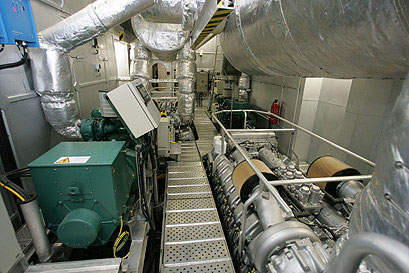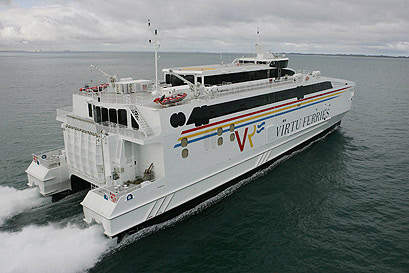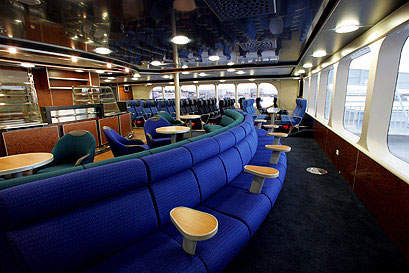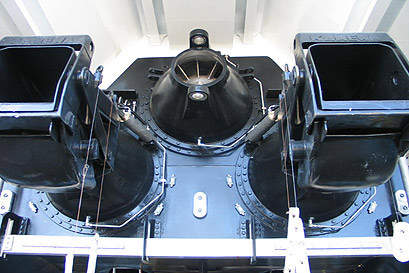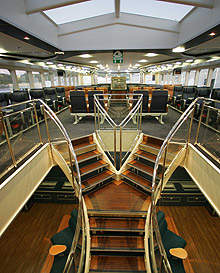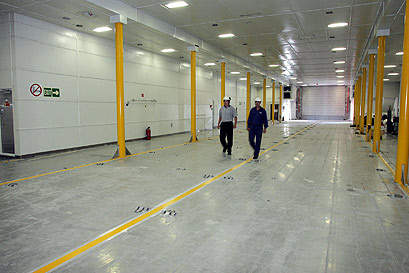The new ferry Maria Dolores has been delivered by Austal to Virtu Ferries. The Auto Express 68 design car and passenger fast ferry will be employed in the Mediterranean, travelling between Malta and Italy. It will complete the journey from Valetta to Catania in 3 hours, to Pozzallo in 90 minutes and to Reggio Calabria in 4 hours.
The Maria Dolores has an overall length of 68.4m and 58.8m on the waterline: it has an 18.2m moulded beam. The moulded hull depth is 6.3m – around 20% higher than comparable size Austal ferries – while the hull draft (max) is 2.6m. It has a 260t deadweight.
Vehicles board and embark from aft and side ramps for rapid turnaround. The ferry can accommodate 65 cars or 95 lane metres with 35 cars. The centre lanes have axle loads of 9t (single wheel) or 12t (dual wheel), while the outer lanes can accommodate axle loads of 2t (single wheel) or 3.5t (dual wheel). The vehicle deck clears a height of 4.6m at the centre lanes and 4.2m at the side lanes.
DESIGN
Passengers enter by the ticketing foyer located on the main/vehicle deck level at midships on the port side. A wide staircase leads to the upper deck where 508 passengers travel in tourist class. Key design features are full height windows in polished stainless steel and Eknes Transit Super Nova seating finished in Svartdal fabric. The ceilings have lightweight Barrisol stretch material. The window mullions are clad in emu leather. Frosted glass panels feature in the bar areas.
Above, on the bridge deck, is the Club class cabin, with seating for a further 92 passengers. This includes high quality upgraded leather clad Eknes seating, a bar and casual seating area. An aft outdoor deck on this level provides room for 30 passengers to move about.
The mezzanine deck provides accommodation with eight bunks, shower and toilet facilities for off-watch crew members. The ferry has a crew of 16.
To maximise the seakeeping potential of the high tunnel height the vessel is fitted with dual SeaState T-Foils and Interceptors, providing maximum passenger comfort across the year round spectrum of sea states.
PROPULSION
The load carrying capacity of the ferry dictated a total kilowatt requirement which was not easily catered for by the four engine installation that was initially considered. In order to be compatible with the Virtu Ferries existing fleet, the ferry was designed to incorporate six MTU 16 cylinder diesel engines, driving six waterjets through six ZF gearboxes. This was therefore the first ever sextuple waterjet installation on a fast ferry.
The engines are six MTU 16V 4000 M71 units, giving an output of 2,465kW each. These are connected to four KaMeWa 80SII waterjets by way of ZF 7650 NR2H gearboxes and two KaMeWa 80BII water jets by two ZF 7650 NR2B gearboxes.
There are two engine rooms per hull, which accommodate two engines in the forward compartment and one engine aft which is raised. This enables a triangular arrangement of the waterjets on the transom.
Unlike conventional installations, this places the centre waterjet above the waterline, meaning that initial propulsion is gained via the lower four steerable / reversible waterjets allowing the subsequent engagement of the two higher booster-only waterjets for full power. The engines give it a service speed: of 35.9 knots at 90%MCR.
The Maria Dolores has a fuel capacity of around 43,600l.
The vessel is built in accordance with the requirements and under the survey of the Det Norske Veritas, conforming to International Maritime Organisation codes and Malta Flag State and Italian Port State Regulations. Registration is under the Malta Flag.

